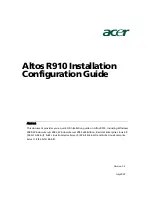
Note:
The latest level of basic input/output system (BIOS) code for your server
is also available through the World Wide Web. See Appendix A, “Getting
help and technical assistance” on page 29 for the appropriate World Wide
Web addresses.
For more information about the ServerGuide CD, see Chapter 3, “Using the
ServerGuide CD” on page 23.
Reliability, availability, and serviceability
Three of the most important features in server design are reliability, availability, and
serviceability (RAS). These factors help to ensure the integrity of the data stored on
your server, that your server is available when you want to use it, and that should a
failure occur, you can easily diagnose and repair the failure with minimal
inconvenience.
The following is an abbreviated list of the RAS features that your server supports:
v
Active PCI and Active PCI-X (hot-plug) adapter slots
v
Automatic error retry and recovery
v
Automatic restart after a power failure
v
BIOS code recovery
v
Built-in, menu-driven electrically erasable programmable ROM (EEPROM) based
diagnostics
v
Built-in monitoring for fan, power, temperature, voltage, and power-supply
redundancy
v
Chipkill Memory protection
v
Control for remote system management provided by the ISMP subsystem
v
Customer support center 24 hours per day, 7 days a week
2
v
Error codes and messages
v
Error correcting code (ECC) on processor bus, L2 and L3 cache, and system
memory
v
Failover support for redundant Ethernet NICs under the Microsoft
®
Windows
®
XP,
Windows 2000, and Windows NT
®
Server operating systems
v
Hot-plug Universal Serial Bus (USB) keyboard and mouse
v
Hot Spare Memory feature
v
Hot-swap and redundant cooling
v
Hot-swap hard disk drives, fans, and power supplies
v
Integrated system management processor (ISMP)
v
Information and Light Path Diagnostics
™
LED panel
v
Key lock support for physical security (tower model)
v
Memory scrubbing and Predictive Failure Analysis (PFA) (background and real
time)
v
Menu-driven setup, system configuration, redundant array of independent disks
(RAID) configuration, SCSISelect configuration, and diagnostic programs
v
Microcode and diagnostic levels available
v
N+N line cords for power supply redundancy
v
Parity checking on the small computer system interface (SCSI) and PCI buses
v
Power managed and Advanced Configuration and Power Interface (ACPI)
compliant
v
Power-on self-test (POST) and Fast POST
v
Predictive Failure Analysis (PFA) alerts on microprocessors, memory, voltage
regulator modules (VRMs), fans, power supplies, and hard disk drives
v
Redundant Ethernet capabilities (with optional adapter)
2. Service availability will vary by country. Response time varies; may exclude holidays.
6
IBM xSeries 255 Type 8685: User’s Guide
Summary of Contents for 8685 - eServer xSeries 255
Page 1: ...User s Guide xSeries 255 Type 8685...
Page 2: ......
Page 3: ...IBM xSeries 255 Type 8685 User s Guide SC32 P020 00...
Page 14: ...xii IBM xSeries 255 Type 8685 User s Guide...
Page 42: ...28 IBM xSeries 255 Type 8685 User s Guide...
Page 56: ...42 IBM xSeries 255 Type 8685 User s Guide...
Page 65: ......
Page 66: ...IBM Part Number 32P0200 Printed in the United States of America 32P 2...
















































